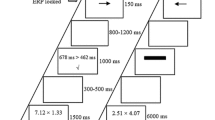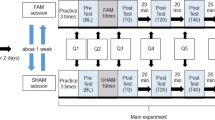Abstract
Stroop interference can be reduced by stress, and this has been taken as evidence that stress decreases the attention paid to irrelevant information, a theory known as ‘Easterbrook’s hypothesis’. This contradicts more recent theories, which state that attentional control deteriorates in stress. Fifty-five participants undertook a Stroop task under high stress (loud white noise) and low stress conditions. Attention to the irrelevant word information was assessed by manipulating the proportion of congruent trials (e.g. the word RED in the colour red); it is known that Stroop interference increases when many such trials are presented. This effect was reduced when participants were stressed, which is evidence that stress does indeed reduce attention to irrelevant information. This pattern of results was not present in participants with low working memory spans, presumably because these participants had less attentional control. These findings highlight an important weakness in contemporary theories of cognition in stress.

Similar content being viewed by others
Notes
The Stroop data were re-analysed with the upper and lower tertiles as the WM groups. The same pattern of results were found as reported in Fig. 1. Furthermore, when Proportion-Congruent effects were calculated by subtracting 0% condition interference scores from 50% condition interference scores, it was found that Proportion-Congruent effects in the 84 dBC condition tended to correlate negatively with Ospan score (r(53) = −0.224, p = 0.099); Proportion-Congruent effects in the 65 dBC condition did not correlate with Ospan scores (r(53) = 0.123, p = 0.26). These findings support our conclusions from our median split analyses.
Although this tendency did not approach significance for RT interference, t(52) = 0.70, p = 0.49, or accuracy interference, t(52) = 1.30, p = 0.20.
References
Baddeley, A. D. (1992). Working memory. Science, 255, 556–559.
Blais, C., Robidoux, S., Risko, E. F., & Besner, D. (2007). Item-specific adaptation and the conflict-monitoring hypothesis: A computational model. Psychological Review, 114, 1076–1086.
Callaway, E. (1959). The influence of amobarbital (amylobarbitone) and methamphetamine on the focus of attention. Journal of Mental Science, 105, 382–392.
Chajut, E., & Algom, D. (2003). Selective attention improves under stress: Implications for theories of social cognition. Journal of Personality and Social Psychology, 85, 231–248.
De Fockert, J. W., Rees, G., Frith, C. D., & Lavie, N. (2001). The role of working memory in visual selective attention. Science, 291, 1803–1806.
Easterbrook, J. A. (1959). The effect of emotion on cue utilization and the organization of behavior. Psychological Review, 66, 183–201.
Eysenck, M. W., Derakshan, N., Santos, R., & Calvo, M. G. (2007). Anxiety and cognitive performance: Attentional control theory. Emotion, 7, 336–353.
Frankish, C. (2002). Lexicus (Version 3.0.1): University of Bristol.
Geen, R. G., & McCown, E. J. (1984). Effects of noise and attack on aggression and physiological arousal. Motivation and Emotion, 8, 231–241.
Huguet, P., Dumas, F., & Monteil, J. M. (2004). Competing for a desired reward in the Stroop task: When attentional control is unconscious but effective versus conscious but ineffective. Canadian Journal of Experimental Psychology, 58, 153–167.
Kane, M. J., & Engle, R. W. (2003). Working-memory capacity and the control of attention: The contributions of goal neglect, response competition, and task set to Stroop interference. Journal of Experimental Psychology: General, 132, 47–70.
Kane, M. J., Conway, A. R. A., Hambrick, D. Z., & Engle, R. W. (2007). Variation in working memory capacity as variation in executive attention and control. In A. R. A. Conway, C. Jarrold, M. J. Kane, A. Miyake, & J. N. Towse (Eds.), Variation in working memory (pp. 21–48). New York: Oxford University Press.
Kenemans, J. L., Wieleman, J. S. T., Zeegers, M., & Verbaten, M. N. (1999). Caffeine and Stroop interference. Pharmacology Biochemistry and Behaviour, 63, 589–598.
Lavie, N., Hirst, A., de Fockert, J. W., & Viding, E. (2004). Load theory of selective attention and cognitive control. Journal of Experimental Psychology: General, 133, 339–354.
Lindsay, D. S., & Jacoby, L. L. (1994). Stroop process dissociations: The relationship between facilitation and interference. Journal of Experimental Psychology: Human Perception and Performance, 20, 219–234.
Mathews, A., & Mackintosh, B. (1998). A cognitive model of selective processing in anxiety. Cognitive Therapy and Research, 22, 539–560.
McFall, S. R., Jamieson, J. P., & Harkins, S. G. (2009). Testing the mere effort account of the evaluation-performance relationship. Journal of Personality and Social Psychology, 96, 135–154.
Melara, R. D., & Algom, D. (2003). Driven by information: A tectonic theory of Stroop effects. Psychological Review, 110, 422–471.
O’Malley, J. J., & Gallas, J. (1977). Noise and attention span. Perceptual and Motor Skills, 44, 919–922.
O’Malley, J. J., & Poplawsky, A. (1971). Noise-induced arousal and breadth of attention. Perceptual and Motor Skills, 33, 887–890.
Pallak, M. S., Pittman, T. S., Heller, J. F., & Munson, P. (1975). The effect of arousal on Stroop color-word task performance. Bulletin of the Psychonomic Society, 6, 248–250.
Stroop, J. (1935). Studies of interference in serial verbal reactions. Journal of Experimental Psychology, 18, 653–662.
Tuholski, S., & Engle, R. W. (2002). OSPAN E-prime version. Retrieved March 17, 2005, from http://psychology.gatech.edu/renglelab.
Turner, M. L., & Engle, R. W. (1989). Is working memory capacity task dependent? Journal of Memory and Language, 28, 127–154.
Van Selst, M., & Jolicoeur, P. (1994). A solution to the effect of sample size on outlier elimination. Quarterly Journal of Experimental Psychology, 47A, 631–650.
Weltman, G., Smith, J. E., & Ergstrom, G. H. (1971). Perceptual narrowing during simulated pressure-chamber exposure. Human Factors, 13, 99–107.
Author information
Authors and Affiliations
Corresponding author
Additional information
This research was carried out while Rob Booth was a doctoral student at the University of Kent, supervised by Dinkar Sharma.
Rights and permissions
About this article
Cite this article
Booth, R., Sharma, D. Stress reduces attention to irrelevant information: Evidence from the Stroop task. Motiv Emot 33, 412–418 (2009). https://doi.org/10.1007/s11031-009-9141-5
Received:
Accepted:
Published:
Issue Date:
DOI: https://doi.org/10.1007/s11031-009-9141-5




